A Visit to a Chinese Hospital
At a Chinese hospital, how many friendly Chinese strangers does it take to help a foreigner get a couple of stitches stir-fried? That is probably a question that has not occurred to you recently. This funny story occurred in a mainland China university hospital in 2008.
What is a hospital in China like? The best of them have medical care that rivals any place in the world. The worst of them are downright scary.
I've had to go to a couple of Chinese hospitals in my 15 years in China. In 2007 I had a CT scan at the provincial teaching hospital. As far as I could tell, it was done quite professionally, although the "line-up" of people waiting for the procedure in the room outside was kind of unruly.
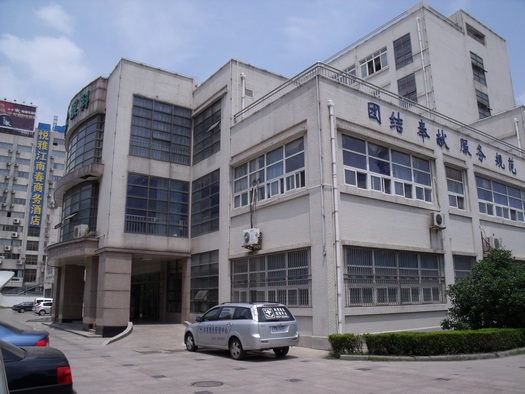
The hospital in this funny story of Chinese medical care is the one on my university campus. All universities have at least a small medical clinic but my university, being an important one, has a large building with around 100 medical staff and doctors.
Here is the story, as I wrote it at that time (2008). As usual, I've included public domain photographs.
This morning I went to the campus hospital to get six stitches removed from my upper arm, and one from my neck.
Lynn, the university international affairs office lady who takes care of us, is very busy today so I decided to try the hospital trip myself as an adventure and an exercise for my Chinese language ability. She taught me to say "chai xian" which means "remove stitches".
Armed with that, off I went to my local Chinese hospital. The university hospital is a large building about six floors high. It's not a complete hospital but it's a lot more than a simple campus clinic. It happens to be particularly renowned for children's eye care, but that doesn't come into my story.
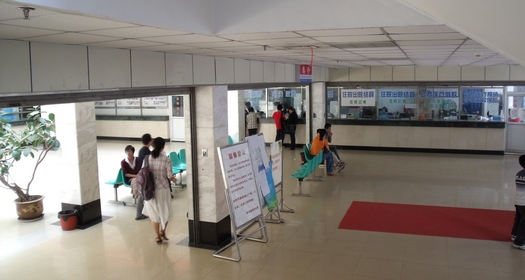
I went to one of the registration windows where a lady (1) directed me to another window. There a man (2) asked me what I was there for. Instead of "chai xian" as Lynn taught me, I mistakenly said "chao xian", which, if I used the tone I think I used, means "stir-fry my stitches".
Not surprisingly, he looked confused. After trying some variations he figured it out, charged me 10 cents for a prescription form, and sent me to a particular room on the second floor. Unfortunately for me, although the rooms have numbers, the people there tend to know the Chinese labels not the actual room number. That makes it interesting for those of us who don't read Chinese characters well!
I found the room and the doctor (3) there asked me some questions and looked at the stitch on my neck. I understood about a third of what he said. In retrospect, I think he was asking how many stitches I wanted removed and I was answering how many days I'd had them. He seemed a bit grouchy but wrote "chai xian" on the form and sent me back to first floor to look for another room, whose name he repeated for me three times.
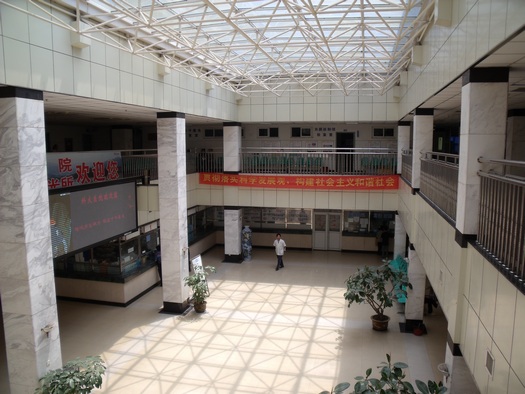
On first floor I could not find the room but saw a nice looking lady (4) in a doctor's lab coat coming out of a room.
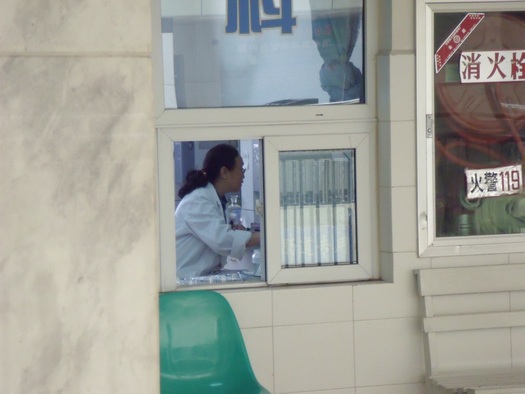
I asked her for help and, joined by her 10-year-old granddaughter (5) who was there to meet her, we went to a room where there were four women (6, 7, 8, 9) having lunch.
One of them looked at the stitch in my neck and said "We didn't put this stitch in", which was perfectly true. I explained it had been done in Thailand, not in a Chinese hospital.
This started a long conversation between Granny (as I'll call my friendly helper) and the first-floor woman, who seemed annoyed and said the stitch was too small and they couldn't remove it here.
Granny wouldn't accept that. I don't know who suggested it, but Granny, Smiley (the grand-daughter) and I ended up going across the lobby to the medicine dispensing room where a 35-ish doctor (10) listened to Granny and sent us all up to fourth floor...
At this point, let me digress to explain something about the cultural revolution of China. It was from mid-1960s to mid-1970s. At that time most universities and even high schools closed. A whole generation lost the chance for higher education, and those who were educated already were often sent to the countryside for re-education through labor.
With a great shortage of doctors, many villages and small towns had only self-taught "bare-foot doctors" who were the ones who could at least read and learn some simple medical techniques. One thing they learned well was using an intravenous. In every Chinese hospital there are special rooms like this one for day patients who come for an hour or two of IV.
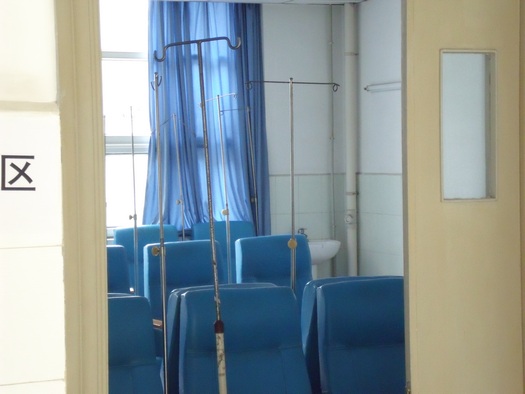
With so many semi-trained doctors from this time period, plus the myriad other sorts of traditional Chinese medicine doctors with various levels of training, China's medical system has developed classes or levels of doctors.
They all get the title "doctor" but their medical training could be less than what we would expect of an average first-aid course graduate. I think the floor 2 doctor I saw was a mid-range, who authorized the floor 1 low-range doctors to remove the stitch.
When they refused, Granny asked a higher-ranking doctor (maybe an administrator) what to do and we got sent to the high-level doctors on fourth floor of the Chinese hospital.
Back to my story now...
On fourth floor Granny found a room of four doctors (11, 12, 13, 14) who were eating lunch. One 35-ish lady seemed to be doctor-in-charge and when Granny explained the situation she looked at my neck stitch.
She too, commented that it was not done here, but with Granny's prodding, a helpless-looking foreigner, and 10-year-old Smiley looking on she said that they could handle it. She assigned a 30-ish young man to remove the stitches.
We trooped down the hall to a small treatment room. With Granny and Smiley looking on, he looked at the arm stitches and seemed intrigued by their colour (blue thread). He said that in China they only use black thread.
Fortunately the stitch colour did not throw him off and soon the six arm stitches were out. Smiley seemed delighted to see this process, with her nose about 2 feet from my arm with Granny looking over her shoulder. Sometime during this process, doctor-in-charge came in and started talking with stitch-remover commenting on how the arm stitches were big and easy.
Then they got to the neck stitch. Stitch-remover, doctor-in-charge, Granny, and yet another lady doctor (12?) who had joined us in the small room (at least until her cell phone rang) all agreed that the neck stitch was small and looked a bit red.
I don't know if Smiley voiced an opinion on this. Stitch-remover said "no problem" and so doctor-in-charge, Granny, and Smiley all looked on from close range as he pulled and snipped and rooted around and finally got it out.
Granny declared this a "gong fei" (public expense) procedure, I thanked them all, and there were smiles all around.
As the elevator doors opened for Granny, Smiley and me to go down to first floor, who should be there but Smiley's father (15). Smiley was jumping up and down with joy as she told the story so father didn't seem to mind the delay in picking her up for lunch.
Down on first floor I thanked Granny again and commented on how friendly and helpful she was. I think she (probably a low-level doctor or perhaps a nurse supervisor herself) was delighted to be part of this international cooperation and modestly said this was just her duty.
Smiley ran across the Chinese hospital lobby to tell her mother (16) all about it. I bet she'll be talking about this for days.
So... I got my stitches out and in the process provided the highlight of the day, a successful international cooperative effort, for 16 people -- 17 counting me.
Here are a few more pictures of Chinese hospitals and medical care in China. All of these were taken in 2010.
Close to my university are several small private hospitals. Here is one with the inspiring name "Sunshine Digestive Diseases Hospital". ("Hefei" is the name of my city.)
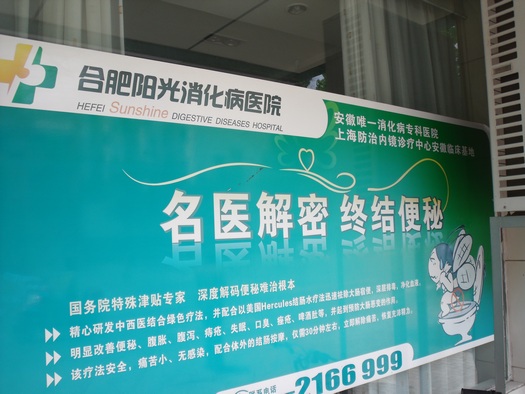
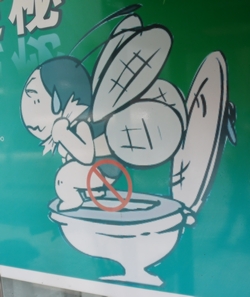
Notice the illustration at the bottom right? Here's a close-up. What a vivid illustration of just who needs this clinic, eh? But is that a bee? some other insect? a constipated fairy?
This Chinese hospital, whoever or whatever its patients are, has a neat and clean foyer and about four floors of rooms. It looks only about three years old.
I don't know what level of doctors work here. Chinese medical law says that to open a hospital or clinic of a certain status, you need to have a certain number doctors of a certain rank.
The paperwork to open a medical establishment can be intimidating so I'd guess there is at least one well-trained medical specialist at this hospital, probably partnering with a paperwork expert. The private medical industry in China seems to have grown a tremendous amount in the last ten years, and there is money to be made as China's middle class develops.
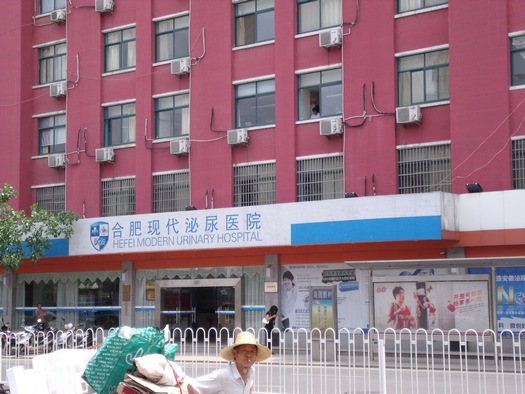
This private Chinese hospital is 6 floors tall. It used to be an obstetrics and gynecology hospital, part of a chain called "Red House Hospital". Yes, they were all painted red, which is a happy, lucky colour to most Chinese people. This branch of the chain apparently went bankrupt and the building was reopened with this new specialty sometime in 2009.
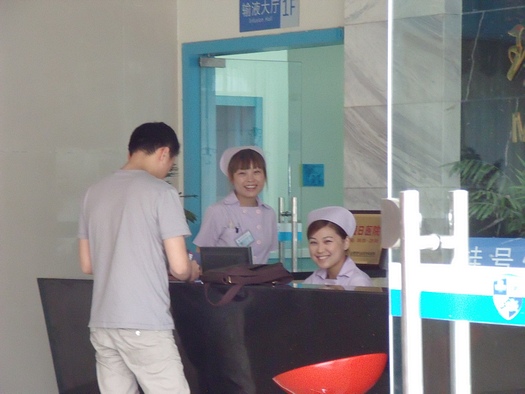
Inside the hospital were these two very friendly-looking ladies, dressed in nurse's uniforms. The uniform doesn't mean anything - the workers in over-the-counter pharmacies also wear Chinese nurse's outfits. These two are probably just administrative staff, but they appear professional this way.
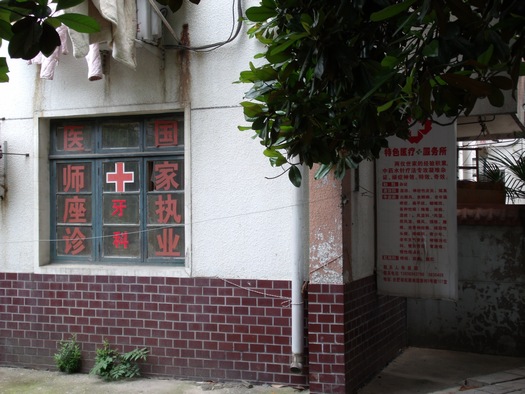
At the low end of the scale are the countryside clinics manned by a single, semi-trained doctor. I don't have any pictures of those, but here is a small neighbourhood medical clinic in an apartment complex. This is a bit like a private doctor's office, but in such places one can never be sure exactly what training the "doctor" has. The left window characters basically say "medical master" and "diagnosis". The middle characters say "tooth science".
Nevertheless, a simple clinic like this can handle minor ailments, and so serves a useful function. It is also a lot cheaper than the private or provincial hospitals.
Let me end this collection of public domain photos of Chinese hospitals with a kind of scary-looking animal hospital.
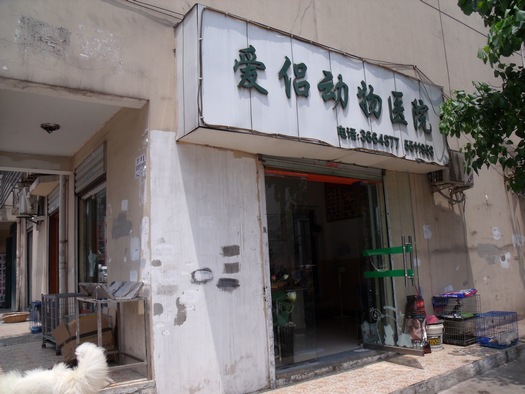
It seems that this place is both a veterinarian's office and a grooming center. I have no idea what training you have to have in China to call yourself a veterinarian.